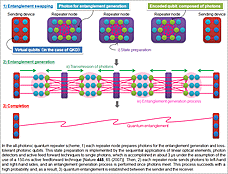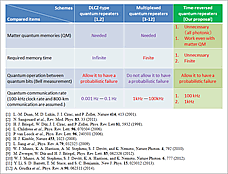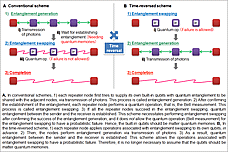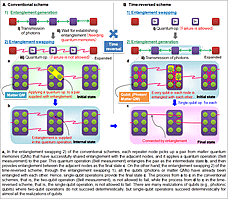Microsoft ends support for Internet Explorer on June 16, 2022.
We recommend using one of the browsers listed below.
- Microsoft Edge(Latest version)
- Mozilla Firefox(Latest version)
- Google Chrome(Latest version)
- Apple Safari(Latest version)
Please contact your browser provider for download and installation instructions.
April 15, 2015
Against a dogma, quantum repeaters for long-distance quantum communication are made all photonic. --Rendering the quantum internet an ultimate challenge for the future photonic network--
Researchers at Nippon Telegraph and Telephone Corporation (NTT; Head office: Chiyoda-ku, Tokyo, Japan; President and CEO: Hiroo Unoura) and the University of Toronto (Toronto, Ontario, Canada; President: Meric Gertler) have proposed the theory of all-photonic quantum repeaters for long-distance quantum communication, disproving a dogma of the necessity of matter quantum memories*1. This paves a completely new route towards long-distance quantum communication based only on optical devices.
Extending the achievable distance of quantum communication not only expands the market of quantum communication but also realizes the ultimately secure communication network for our social life. Our finding renders such a worldwide quantum communication network or 'quantum internet' an ultimate challenge for the future photonic networks.
This work will be made public by the journal Nature Communications on 15th April, 2015.
This research is in part executed under the Project UQCC by the National Institute of Information and Communications Technology (NICT).
Background
Quantum communication holds promise for applications that are intractable by conventional communication--such as quantum cryptography*2 and quantum teleportation*3--by utilizing quantum systems such as atoms and photons*4. Among various applications of quantum communication, the most advanced one is quantum cryptography which is secured by the laws of physics. In fact, field demonstrations of the quantum cryptography over a hundred kilometres have already been performed, for instance, represented by the Tokyo QKD network*5, and even the commercial products are available. So far, such quantum communication has been composed only of optical devices. However, to extend the communication distances from intracity ones (~ 100 km) to international (~ 1000 km) or intercontinental ones (~ 10000 km), we necessitate quantum repeaters, where 'matter quantum memories' were believed to be needed in addition to optical devices. As a result, proof-of-principle experiments for matter quantum memories have extensively been performed by lots of research groups in the world. However, unfortunately, the required matter quantum memories are demanding. Hence, as long as matter quantum memories are required, quantum repeaters may be more difficult than a quantum computer without a future experimental breakthrough.
Results
NTT and the University of Toronto theoretically propose 'all-photonic quantum repeaters' with optical devices alone and without any matter quantum memory, disproving the dogma of the necessity of matter quantum memories for quantum repeaters. Our all-photonic scheme paves a completely new route towards long-distance quantum communication based only on optical devices, rendering the quantum communication network the ultimate future of the current optical communication. In contrast to conventional quantum repeaters based on matter quantum memories, our scheme has the advantages listed below, opening up the possibility of a worldwide quantum communication network or 'quantum internet'.
Distinguished advantages of our all-photonic quantum repeaters:
- Highest quantum-communication rate with no limit. Conventional quantum repeaters utilize the memory function of matter quantum memories for a wait required underway. This waiting time limits the quantum-communication rate. In contrast, the matter-less nature of our all-photonic scheme does not have such a limitation at all. As a result, our all-photonic quantum repeater scheme can present the highest repetition rate, which is comparable with the working speed of optical devices irrespectively of the communication distances.
- Un-necessity of quantum interfaces between matter and photons. Conventional quantum repeaters necessitate quantum interfaces to connect photons for communication with matter quantum memories, although the interfaces are still in the level of the proof-of-principle experiments. In contrast, since our scheme works only with photons for communication, it does not need such quantum interfaces.
- All the basic optical elements have already been developed. All-photonic quantum repeaters are based on optical devices such as linear optical elements*6, single-photon sources*7, photon detectors*8 and an active feedforward technique*9. But, the proof-of-principle experiments have already been performed, which is moving ahead more than matter quantum memories.
- It could work even at room temperature. Matter quantum memories usually need cryogenic temperature to suppress the noise. However, our scheme could work even at room temperature, thanks to the matter-less nature.
- Milestone for a quantum computer. In contrast to conventional schemes based on matter quantum memories, our all-photonic quantum repeater is proven to be much easier than a quantum computer (based on photons). This implies that long-distance quantum communication based on all-photonic quantum repeaters will be realized much earlier than a quantum computer, and there is an optical quantum computer as the future of the developments of optical devices required by the all-photonic quantum repeaters. Therefore, our quantum repeater plays the role of a certain milestone for a quantum computer.
- Discovery of the role of photons as a unified language for quantum information processing protocols. Our scheme proves that, besides quantum computing, even long-distance quantum communication is feasible only with photons. This ensures that any quantum information processing protocol can be described by 'photons' as a unified language, which would lead to unified understanding of quantum information processing protocols that have conventionally been divided into the communication and the computation.
Outlook
Quantum repeaters are necessary for extending the achievable distances of quantum communication, and the realisation not only expands the market of quantum communication but also realizes the ultimately secure communication network for our social life. On the other hand, in the conventional communications, there has been an approach to the 'photonic network' based on optical devices alone towards reducing the power consumption and boosting up the communication speed. Our finding of all-photonic quantum repeaters presents such a conventional research on optical devices with a qualitatively new goal--the quantum internet--as the ultimate future of the photonic network. The all-photonic scheme was just born in the area of the theory, and the realisation still needs to wait further developments of optical devices such as linear optical elements, single-photon sources, photon detectors and an active feedforward technique. However, the step-by-step progress certainly contributes the realisation of not only the all-photon quantum repeaters but also the quantum internet. This may take long time, but it must be fascinating and fantastic journey.
Technical points
In contrast to conventional theories that need matter quantum memories, all-photonic quantum repeaters without them, of course, have a conceptual jump. This should be called 'time reversal'.
The goal of quantum repeaters is to supply quantum entanglement*10--which is a resource for quantum communication--to the sender and the receiver, by utilizing repeater nodes between them (Fig. 1 ).
To achieve this goal, quantum repeaters perform two operations, 'entanglement generation' and 'entanglement swapping'. Conventional schemes equip each repeater node with matter quantum memories and the quantum interfaces between matter and photons, and start by the entanglement generation, followed by the entanglement swapping (Fig. 2
).
However, our all-photonic quantum repeater scheme is based on taking the time reversal, that is, on a time-reversed protocol where the entanglement generation is performed after the entanglement swapping (Figs. 2
and
3
).
Indeed, the all-photonic quantum repeater protocol is all-optical implementation of the time-reversed protocol (Fig. 4
).
The time-reversed protocol is not only feasible only with photons, but also inherits only the advantages of the conventional quantum repeaters (Table 1
).
 Figure 4: All-photonic quantum repeater protocol
Figure 4: All-photonic quantum repeater protocol
 Table 1: Comparison between conventional schemes and the time-reversed scheme
Table 1: Comparison between conventional schemes and the time-reversed scheme
click image to enlarge
Publication information
Koji Azuma, Kiyoshi Tamaki and Hoi-Kwong Lo,
'All-photonic quantum repeaters',
Nature Communications [15th April, 2015 (BST)].
doi: 10.1038/ncomms7787
Glossary
*1Matter quantum memory
The function to store the quantum superposition states for a certain period of time. For instance, in contrast to the memory in the conventional computers that can store both of bit values 0 and 1, quantum memory can keep not only 0 and 1 but also their quantum superposition states.
A 'matter quantum memory' is the realization of the quantum memories based on matter such as an atomic ensemble, a single atom, an ion trap, a quantum dot, a superconducting qubit and a nitrogen-vacancy centre in a diamond.
*2Quantum cryptography
If a sender and a receiver share a 'secret key' that is composed of random bits unpredictable by anyone (except for the sender and the receiver), by consuming it, they can perform cryptographic communication through public communication channels such as the wireless communications and the Internet (Vernam cipher). Quantum cryptography is a method to supply the sender and the receiver with such a secret key through the exchange of quantum superposition states between them. It is also called 'quantum key distribution (QKD)'. For instance, in QKD over a hundred kilometres, the sender and the receiver generate bit strings via exchanging photons between them, correct the bit errors in the bit strings and then properly shorten the reconciled bit strings according to the estimation of the leaked information to the eavesdropper (nature) in order to obtain a secret key.
*3Quantum teleportation
Teleporting of a quantum superposition state of sender's physical system to a receiver, by utilizing the pre-shared 'quantum entanglement' together with conventional communication such as the telephone and the internet. One may regard this as a science fiction, but its experimental demonstrations have already been performed by using, for example, photons and atoms.
*4Photon
The particle-like aspect of light. A single photon is the unit of energy of light that cannot be divided furthermore. For instance, if we input a single photon into a beam splitter, the output photon is in a quantum superposition state.
*5Tokyo QKD network [http://www.nict.go.jp/en/press/2010/10/14-1.html]
QKD network using part of NICT's open fibre test-bed network JGN2plus, operated by the National Institute of Information and Communications Technology (NICT) in cooperation with its commissioned research partners NEC, Mitsubishi Electric and NTT. In this field network operation, Toshiba Research Europe Ltd and other European organizations have also participated in an effort to promote standardization of the interconnection technology between Japanese and overseas QKD systems.
*6Linear optical elements
Optical devices preserving the number of photons. The examples are a beam splitter, a half-wave plate, a quarter-wave plate, a phase shifter, a polarizing plate and a polarizing beam splitter.
*7Single-photon source
A source that can output a single photon in an on-demanding manner.
*8Photon detector
A detector that can detect a single-photon level of light.
*9Active feedforward technique
A technique to switch the linear optical circuit at high speed, depending on the previous measurement outcomes from photon detectors (for instance, by using optical switches).
*10Quantum entanglement
A quantum superposition state of composite systems that can never be expressed by any collection of the descriptions of the subsystems. This is an essential resource for quantum communication and quantum computation. The existence has already been experimentally demonstrated by using photons and atoms.
Press Contact
Nippon Telegraph and Telephone Corporation
Science and Core Technology Laboratory Group, Public Relations
Tel +81-46-240-5157
e-mail a-info@lab.ntt.co.jp
Information is current as of the date of issue of the individual press release.
Please be advised that information may be outdated after that point.
NTT STORY
WEB media that thinks about the future with NTT














